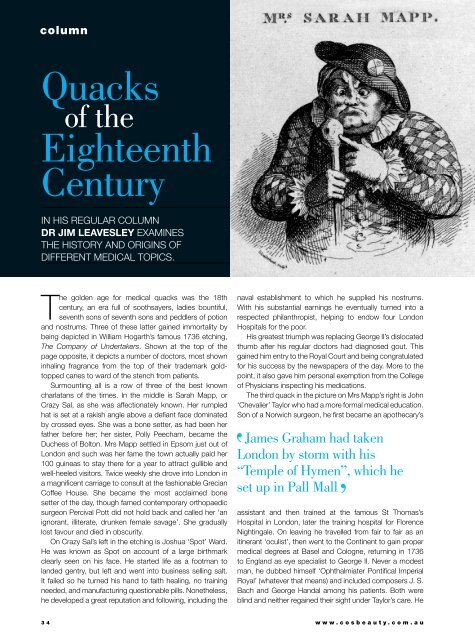Cosmetic Surgery and Beauty Magazine #66
Cosmetic Surgery and Beauty is the must-read for anyone considering a cosmetic procedure or treatment. With hundreds of before and after photo, and cosmetic and plastic surgery experts featured, tis educational resource will allow you to confidently decide the best course of action. This issue includes features on: Breast reshaping Six ways to get younger looking skin Surgical vs non-surgical fat reduction Body soothing products Energy boosters DIY perfect makeup As well as regular features on breast augmentation, facelifting, rhinoplasty and liposculpture/liposuction.
Cosmetic Surgery and Beauty is the must-read for anyone considering a cosmetic procedure or treatment. With hundreds of before and after photo, and cosmetic and plastic surgery experts featured, tis educational resource will allow you to confidently decide the best course of action.
This issue includes features on:
Breast reshaping
Six ways to get younger looking skin
Surgical vs non-surgical fat reduction
Body soothing products
Energy boosters
DIY perfect makeup
As well as regular features on breast augmentation, facelifting, rhinoplasty and liposculpture/liposuction.
You also want an ePaper? Increase the reach of your titles
YUMPU automatically turns print PDFs into web optimized ePapers that Google loves.
column<br />
Quacks<br />
of the<br />
Eighteenth<br />
Century<br />
In his regular column<br />
Dr Jim Leavesley examines<br />
the history <strong>and</strong> origins of<br />
different medical topics.<br />
The golden age for medical quacks was the 18th<br />
century, an era full of soothsayers, ladies bountiful,<br />
seventh sons of seventh sons <strong>and</strong> peddlers of potion<br />
<strong>and</strong> nostrums. Three of these latter gained immortality by<br />
being depicted in William Hogarth’s famous 1736 etching,<br />
The Company of Undertakers. Shown at the top of the<br />
page opposite, it depicts a number of doctors, most shown<br />
inhaling fragrance from the top of their trademark goldtopped<br />
canes to ward of the stench from patients.<br />
Surmounting all is a row of three of the best known<br />
charlatans of the times. In the middle is Sarah Mapp, or<br />
Crazy Sal, as she was affectionately known. Her rumpled<br />
hat is set at a rakish angle above a defiant face dominated<br />
by crossed eyes. She was a bone setter, as had been her<br />
father before her; her sister, Polly Peecham, became the<br />
Duchess of Bolton. Mrs Mapp settled in Epsom just out of<br />
London <strong>and</strong> such was her fame the town actually paid her<br />
100 guineas to stay there for a year to attract gullible <strong>and</strong><br />
well-heeled visitors. Twice weekly she drove into London in<br />
a magnificent carriage to consult at the fashionable Grecian<br />
Coffee House. She became the most acclaimed bone<br />
setter of the day, though famed contemporary orthopaedic<br />
surgeon Percival Pott did not hold back <strong>and</strong> called her ‘an<br />
ignorant, illiterate, drunken female savage’. She gradually<br />
lost favour <strong>and</strong> died in obscurity.<br />
On Crazy Sal’s left in the etching is Joshua ‘Spot’ Ward.<br />
He was known as Spot on account of a large birthmark<br />
clearly seen on his face. He started life as a footman to<br />
l<strong>and</strong>ed gentry, but left <strong>and</strong> went into business selling salt.<br />
It failed so he turned his h<strong>and</strong> to faith healing, no training<br />
needed, <strong>and</strong> manufacturing questionable pills. Nonetheless,<br />
he developed a great reputation <strong>and</strong> following, including the<br />
naval establishment to which he supplied his nostrums.<br />
With his substantial earnings he eventually turned into a<br />
respected philanthropist, helping to endow four London<br />
Hospitals for the poor.<br />
His greatest triumph was replacing George II’s dislocated<br />
thumb after his regular doctors had diagnosed gout. This<br />
gained him entry to the Royal Court <strong>and</strong> being congratulated<br />
for his success by the newspapers of the day. More to the<br />
point, it also gave him personal exemption from the College<br />
of Physicians inspecting his medications.<br />
The third quack in the picture on Mrs Mapp’s right is John<br />
‘Chevalier’ Taylor who had a more formal medical education.<br />
Son of a Norwich surgeon, he first became an apothecary’s<br />
James Graham had taken<br />
London by storm with his<br />
“Temple of Hymen”, which he<br />
set up in Pall Mall<br />
assistant <strong>and</strong> then trained at the famous St Thomas’s<br />
Hospital in London, later the training hospital for Florence<br />
Nightingale. On leaving he travelled from fair to fair as an<br />
itinerant ‘oculist’, then went to the Continent to gain proper<br />
medical degrees at Basel <strong>and</strong> Cologne, returning in 1736<br />
to Engl<strong>and</strong> as eye specialist to George II. Never a modest<br />
man, he dubbed himself ‘Ophthalmiater Pontifical Imperial<br />
Royal’ (whatever that means) <strong>and</strong> included composers J. S.<br />
Bach <strong>and</strong> George H<strong>and</strong>al among his patients. Both were<br />
blind <strong>and</strong> neither regained their sight under Taylor’s care. He<br />
34 www.cosbeauty.com.au

















